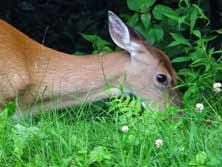First, any good deer control strategy starts with making sure you have a deer problem. Look for tracks and signs of droppings and urine dead spots. Jagged damage on woody plants is another clue.
Deer usually venture into a yard looking for food. Although the homeowner may not spot them, the deer leave signs. One of the most obvious is their droppings. Deer scat looks like small, round marbles. It may be left in a pile, but sometimes the deer doesn't pause so there is a trail instead. Deer are large animals, which means they can leave a sizable amount of droppings, and this can be bad news for any lawn.
Deer urine also may be detrimental to the lawn. Once again, because deer are large, they are capable of expelling massive amounts of urine. This can easily leave an unattractive burn circle that is difficult to treat.
Of course, deer enter yards to find food. Grass is among their favorites. Deer aren't considerate enough to graze evenly. Instead, they'll browse in one spot and then another, leaving an uneven surface. They don't stop at just eating grass. Deer love all sorts of plants, trees and shrubs. Some of these plant species can actually attract deer to your yard.
A professional deer control program typically includes a combination of the following strategies:
Repellents: Professional deer control programs often use repellents, which are substances that emit an unpleasant odor or taste to discourage deer from entering a specific area. Read about odor based repellent and taste based repellents. These can be in the form of sprays, granules, or stake-mounted emitters. Sprays are changed depending on the season of the year.
Habitat modification: A professional deer control program can also include measures to modify the habitat so that it is less attractive to deer. This can include removing food sources, such as ornamental plants, or creating physical barriers that make it difficult for deer to access a specific area. These can be temportary like mesh deer fencing or more permanate like wire fencing or electric fencing. Planting deer resistant plants is encouraged. Noise or fencing may need to be involved. Motion-activated sprinklers Motion Detector Deer Repellent are perennially popular for deterring deer. An infrared sensor detects movement, which then activates the sprinkler. Some models also emit a startling sound. The sprinkler scares away the deer, leaving your lawn safe.
Soil Treatment: Many arboretums, nurseries, and orchards apply Milorganite the surface of the ground to repel deer. This is a 2 for 1 deer control and soil amendment service. Milorganite is high in iron and will green a lawn up well.
Monitoring: Regular monitoring of deer populations and damage is an important aspect of a professional deer control program, to be able to adjust the methods and strategies in response to the conditions and changing population. Trail cameras are less than $100 and the perfect monitoring system. Choose a trail camera for deer monitoring you can access remotely so you can check on the property regularly without going to the landscape.


